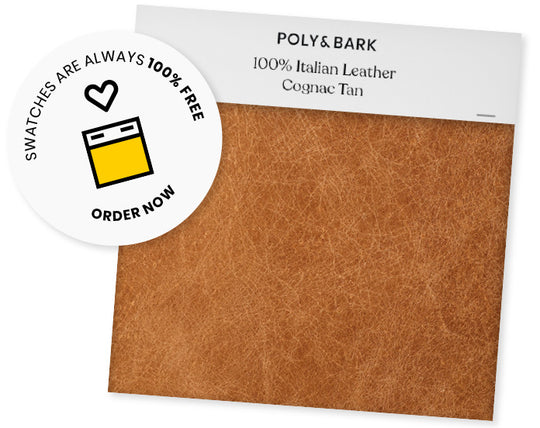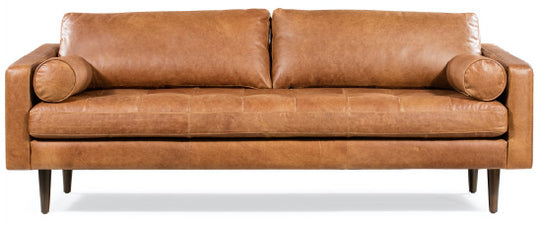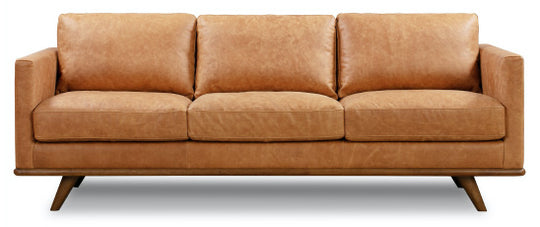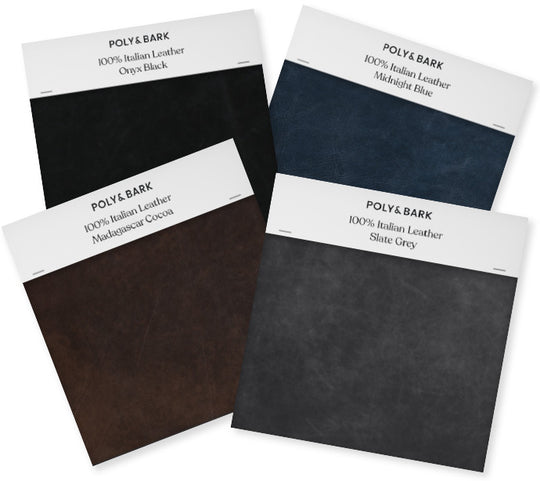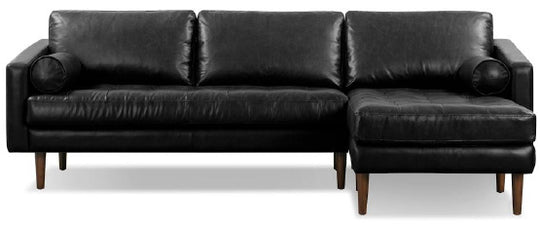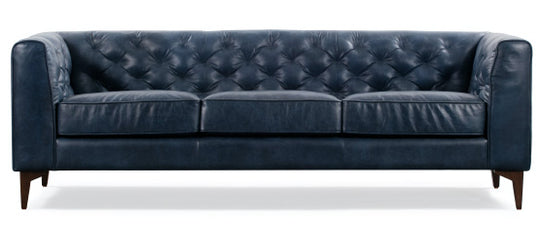THE OWNER’S MANUAL
Leather Furniture
Full Grain Leather 101
Full grain leather is any animal hide’s topmost layer that hasn’t been corrected (i.e. buffed to remove irregularities and/or coated with oils). Because the natural grain pattern in this layer contains the strongest fibers in the hide, it’s thicker, extremely durable and when it comes to crafting furniture, more labor-intensive. For these reasons, it’s easily the highest grade out there (hence the price tag).
Full grain leather is also loved for its super soft feel thanks to the natural oils already present in the hides—pieces made from it are pliable and feel comfy, never stiff. The naturally porous hide is also extremely breathable, which means over time, it’ll collect less moisture from prolonged contact/use. Translation? It’ll stay looking new for longer.


One-Of-A-Kind Look
By design, full grain hides showcase the animal’s organic, lived-in imperfections and even markings from its contact with the environment. That’s why no two are exactly alike—each piece is completely unique.
These markings run the gamut, including things like:
- Scratches + natural scarring from plants like cacti
- Scuffs from contact with fences, gates and other manmade structures
- Uneven coloring and lines from wrinkles, veins, stretch marks + fatty areas
- Spots + natural discoloration from warts, pores, insect bites and freckles
This perfectly imperfect look is why we choose full grain for all of our pieces—because every hide is a top-to-bottom, end-to-end original. Whether it’s an ottoman, bench or a show-stopping sectional, integrating full grain leather into any space adds inimitable character and charm that can’t be duplicated. Wondering if leather is safe for pets? Read our FAQs below.

The Fine Wine of Leathers
Say it with us: patina [pah-teen-uh]. Patina refers to the surface appearance of something after time. Full grain leather is designed to look better the longer you use it because it’s naturally flawed patina also collects new scratches and scuffs “on purpose”—in fact, the raw hide is intentionally left unaltered by outer coatings and embossing treatments for this very reason: to gradually become a piece that reflects the unique markings, personality and story of the home it’s in.
Leather That Shows Its True Colors
To preserve—and play up—the organic look of full grain leather, all of our leather color options are either
PURE ANILINE DYED
This premium treatment helps bring out the unique markings of raw hides even more thanks to the translucent, water-based tint used to color the leather—the tint penetrates in a way that allows every organic scratch, scuff and scar to remain intact. And because different parts of the hide naturally absorb varying levels of dye, the final product comes out visually nuanced with depth, dimension and shade variations throughout.
In addition, this process foregoes the use of topcoats or any additional protective finishes, keeping the leather ultra-breathable, soft and intentionally more receptive to new markings, too. This way, over time the surface becomes a unique, blended mix of ‘imperfections’—a rich vintage patina that adds one-of-a-kind character to your home.
PROS
Organic, au naturale look; very soft, supple and breathable (read: a super comfortable sit); develops a warm, vintage patina over time
CONS
Light and sun sensitive;
requires some maintenance
All of our Cognac Tan and Saddle Tan leather pieces are crafted from pure-aniline dyed, full grain hides.
SEMI-ANILINE DYED
This treatment uses the same translucent, water-based tint as pure aniline dyes—so you’ll still see the raw hide’s natural markings—but adds a protective, subtly pigmented topcoat for a more uniform, evenly colored look. This coating also makes semi-aniline pieces easier to clean, more kid-and-pet friendly than pure aniline leather and ideal for high-traffic areas.
PROS
More durable; can stand direct sunlight and generally more wear + tear; maintains an even, color-consistent look over time; easier to clean
CONS
Has a slightly waxier feel due to the topcoat; patina will be less variegated due to protective finish
Our semi-aniline leather shades include our Onyx Black, Midnight Blue, Madagascar Cocoa and Olivine Green.
HOW-TO GUIDE
Cleaning Tips + Tricks
Spot + Stain Removal
Rub a moistened finger on minor scuffs to buff them out.
Use a damp cloth to wipe down areas that require a deeper clean.
Tips + Tricks
Always test cleaning products on a non-visible area first.
Avoid placing leather in direct sunlight as it will fade faster.
Avoid applying heat to full-grain leather if it gets wet because it could lead to cracking. Always let full-grain leather air dry at room temperature.
Care + Maintenance
To prevent over-drying, apply a leather conditioning oil to treat the leather every 3 to 6 months.
Poly & Bark Approved: Tools of the Trade
We recommend the following cleaning products for our leather pieces:
CLEANING CLOTH

NATURAL CHAMOIS OR
OTTER WAX FLANNEL BUFFING CLOTH
PRO TIP: It’s important to use soft cleaning cloths that won’t scratch, damage or remove the coloring of your leather.
CONDITIONING

OTTER WAX LEATHER OIL
OR OTTER WAX LEATHER SALVE
PRO TIP: Do not use other conditioning products such as Otter Wax Saddle Soap, or any leather wipes. These may cause the naturally porous hides to dry out, leading to irreversible damage. Only pure or natural oils should be used. If you are unsure, please test on an inconspicuous area of your item.
We're here to help
Frequently Asked Questions
Can I add my own waterproof coating at home?
No. Unfortunately, there's no way to completely waterproof any leather item. And to preserve the life of your product, we don’t recommend applying anythingto our pieces other than the Otter Wax Leather Salve or the Otter Wax Leather Oil we’ve listed under ‘Cleaning Tips + Tricks’. Both products will help maintain your leather and give it some resiliency over time.
What type of leather is best for homes with pets?
We recommend any of our semi-aniline dyed leather pieces. Semi-aniline leather is more pet-friendly, kid-friendly and ideal for high-traffic areas because the dyeing process—while still showcasing the natural markings of the full-grain hide—includes a protective topcoat that is easier to clean, more durable overall and resistant to wear + tear.
It should be noted that no leather is 100% claw-proof! Tearing can still happen depending on the pressure, force and frequency of the scratching/clawing.
My brand new leather item looks like there’s pen marks. Is it defective?
No! Actually, these marks are what make full-grain leather the most sought after leather on the market. Full-grain hides are intentionally left untreated to showcase the organic, lived-in imperfections of the animal’s skin—the pen-like marks you’re seeing on the hide are likely healed scars from scratches against barbed wire fences and plants like cacti. This is also why your item—and every leather item we make—is a unique, one-of-a-kind piece.
Why does it look like there are water drop stains on my brand new leather item?
Great question! Full-grain hides are intentionally left untreated to showcase the organic, lived-in imperfections of the animal’s skin—the ‘water drop’ stains you’re seeing on the hide are likely natural skin discolorations from things like warts, insect bites and freckles. This is also why your item—and every leather item we make—is a unique, one-of-a-kind piece.
Why do leather items in cognac tan show more wear and tear?
Unlike the rest of our leather colors, our Cognac Tan and Saddle Tan pieces are pure-aniline dyed. That means by design, there’s no protective topcoat or pigmentation added to even out some of the natural discoloration and irregularities of the raw hide, making it intentionally more receptive to/likely to show normal wear + tear marks like scuffs and scratches. This way, over time the surface becomes a unique, blended mix of markings—a warm, more rich vintage patina that adds one-of-a-kind character to your home.


